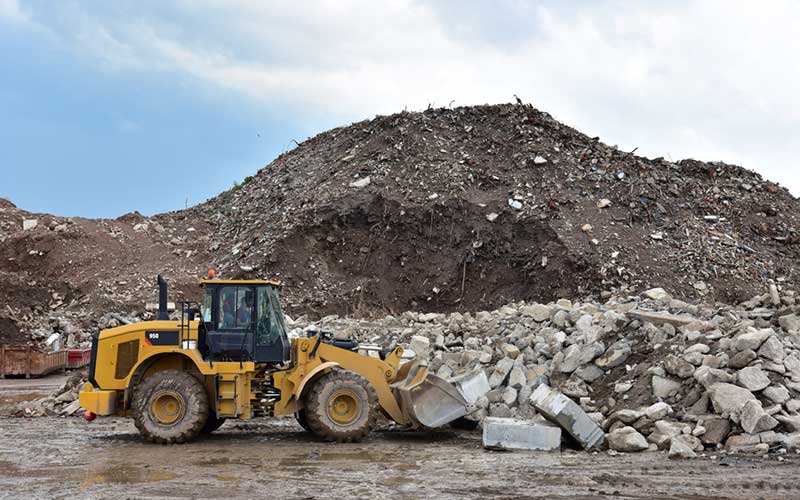
Burying out-of-state waste at Juniper Ridge harms Maine’s ability to manage its own waste and threatens residents’ health and quality of life. Photo: Maksim Safaniuk via Shutterstock
Maine’s Juniper Ridge Landfill was never supposed to accept out-of-state waste, and there’s no good reason why it should. The State purchased the landfill to provide disposal capacity for Mainers’ waste, not the rest of New England.
Yet, the landfill has been burying thousands of tons of out-of-state construction and demolition debris for years. How? Through a loophole in the law. Casella Waste Systems operates the landfill on behalf of the State, and ReSource owns a waste processing facility in Lewiston, Maine. They have been colluding to import out-of-state debris by disguising it as Maine-generated waste. All so it can be dumped at the Juniper Ridge Landfill.
A bill (LD 1639) that would close the loophole for good is gaining momentum – and exposing Casella and ReSource’s collusion. Yet, with their scheme laid bare, both companies are spreading myths to confuse legislators and the public. We’re here to bust those myths and explain exactly why we need to close this loophole once and for all.
Exploiting a Loophole to Dump Out-of-State Waste
Before we bust some myths, it’s important to understand just how Casella and ReSource scheme to bury thousands of tons of out-of-state waste in Maine’s Juniper Ridge Landfill every year. Here’s what you need to know:
- ReSource gets paid by the ton to take in construction waste from across New England.
- About 90% of this waste comes from outside of Maine, and the company only recycles about 10% of it – on a good day.
- Through the loophole, the remaining waste is classified as in-state waste – because it is now “leftover” from ReSource’s Maine facility.
- This out-state-waste-in-disguise then gets sent to the Juniper Ridge Landfill as either oversized bulky waste, like appliances and couches, or as crushed-up construction materials.
- ReSource pays Casella by the ton to dump all this out-of-state waste at Juniper Ridge.
- These disposal costs are only a fraction of what the company makes from accepting the out-of-state waste – that’s how ReSource makes its money.
Busted: Casella Needs Crushed-Up Construction Material for Landfill Cover
Casella claims that it needs the crushed-up construction material that ReSource supplies as landfill cover. That’s simply not true. There are several greener options that Casella could use. Those alternatives are just less lucrative for Casella, so the company ignores them.
According to landfill experts, the most sustainable landfill cover is a retractable tarp. This saves space in the landfill, as you can remove the tarp during the day and cover the landfill at night. When using waste, like construction and demolition debris, that material becomes part of the landfill – and is covered with more waste the next day. A retractable tarp also helps prevent water from entering and flowing through the landfill (that water then creates leachate, a toxic garbage juice that leaks into the ground). Another environmentally friendly alternative is soil-like material, like contaminated sediment and compost, which are readily available in Maine.
The bottom line is that Casella doesn’t need to use crushed-up construction materials for landfill cover. But to drive the point home, experts also say that the construction material Casella currently uses is only appropriate in very arid regions, due to its contribution to hydrogen sulfide gas production. This means the construction debris is environmentally harmful when used as landfill cover in Maine.
Busted: Casella Needs Oversized, Bulky Waste to Stabilize Landfill Sludge
Each year, the Juniper Ridge Landfill buries a significant amount of sludge from wastewater treatment plants. The problem is that sludge isn’t stable – it moves with gravity. To stabilize the wastewater sludge in the Juniper Ridge Landfill, Casella mixes it with oversized, bulky items like mattresses and drywall. The idea is that these materials will absorb the moisture and make the sludge more stable so that it doesn’t shift around in the landfill. Casella claims there are no better alternatives to stabilize the sludge. But experts disagree, saying this tactic is uncommon.
More common options for stabilizing sludge include using sawdust or contaminated soils – materials Casella could easily obtain. But the most sustainable way to manage it is to drain or dry the sludge to the point where it does not need to be stabilized by other waste. This practice also reduces climate-damaging emissions from landfills.
Busted: ReSource Will Shut its Doors if the State Closes the Loophole
Fearmongering is a common tactic that companies use to put profit over the best interests of people and the environment. And that’s exactly what ReSource and Casella are trying to do – scare the legislature and public into thinking the Lewiston facility will shut down if the loophole is closed. They’re doing so by talking about the impact the facility’s closure will have on the town, like loss in jobs and services. Currently, Lewiston sends all its construction and demolition debris to ReSource’s facility for free. Meaning, if the facility closes, the town will have to start paying for disposal, which will inevitably increase costs for residents.
But here’s what they’re not telling you: ReSource’s Lewiston facility has been in operation since 1985, and over the years, it’s changed how it does business many times. There’s no reason the company can’t do it again to better reflect Maine’s environmental values (as every other waste facility in Maine has done). What’s more, ReSource is owned by a $70 billion global asset management company, which has resources to invest in more innovative and responsible ways of doing business.
Busted: It Doesn’t Matter Where the Waste Goes
It does matter. The State purchased the Juniper Ridge Landfill to provide a lasting and secure place to handle the waste generated in Maine, by Maine people, for years to come. Because of this loophole, roughly one-third of all the waste buried at Juniper Ridge originated from out of state. This means the landfill is filling up quicker than expected and needs to constantly be expanded. At its current fill rate, a new expansion is anticipated in only six years.
The practice of dumping out-of-state waste at Juniper Ridge has a direct impact on those who live in its shadow. That includes tribal members of the Penobscot Nation, who worry about the air they breathe and the water they drink, along with odors, pollution, truck traffic, and property values. The United States has a disturbing legacy of putting landfills and other polluting facilities in underrepresented and marginalized communities. It should not be acceptable to continue doing this in Maine.
Closing the Out-of-State Waste Loophole
Casella’s and ReSource’s objections to LD 1639 are based solely on their own financial interests. Any argument they make against a law that will protect and preserve the capacity of Maine’s only State-owned landfill should be scrutinized by lawmakers.
Burying out-of-state waste at Juniper Ridge harms Maine’s ability to manage its own waste. What’s more, it threatens residents’ health and quality of life. That’s why CLF and the Natural Resources Council of Maine are working with Community Action Works, Don’t Waste Maine, and other partners to close the out-of-state waste loophole – for good.
We need to be forward-thinking about managing our own waste. That includes preserving the capacity of Maine’s State-owned landfill for the people of Maine, as it was intended.
A version of this blog was originally published on the Natural Resources Council of Maine’s website.




